The EV transmission system market is progressing steadily, driven by the rapid adoption of electric vehicles and continued improvements in drivetrain efficiency. Industry updates and OEM announcements have emphasized the importance of lightweight, compact, and low-maintenance transmission systems in supporting next-generation EV architectures.
Battery electric vehicles (BEVs), in particular, have seen strong production and sales growth as governments strengthen zero-emission vehicle mandates and automotive manufacturers expand their all-electric product lines. Technological innovations in electric powertrains have enabled integration of optimized transmission systems, contributing to smoother torque delivery, improved energy efficiency, and better thermal performance.
Additionally, automotive suppliers are investing in single-speed and continuously variable transmission (CVT) systems designed specifically for EVs, aiming to enhance driving range and reduce mechanical complexity. Press releases and investment briefings from automotive component companies indicate increased capital flow into dedicated EV transmission platforms, with a focus on modular designs and scalable integration. Looking forward, as BEV penetration rises and vehicle performance expectations increase, demand for advanced transmission configurations is expected to accelerate further, supporting long-term market expansion.
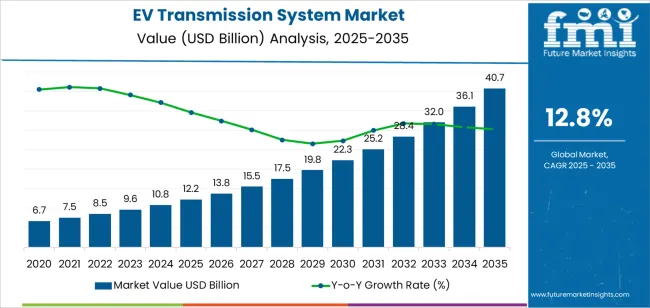
| Metric | Value |
|---|---|
| EV Transmission System Market Estimated Value in (2025 E) | USD 12.2 billion |
| EV Transmission System Market Forecast Value in (2035 F) | USD 40.7 billion |
| Forecast CAGR (2025 to 2035) | 12.8% |
The market is segmented by Vehicle Type, Transmission Type, and Transmission System and region. By Vehicle Type, the market is divided into Battery Electric Vehicle, Plug-in Hybrid Electric Vehicle, and Hybrid Electric Vehicle. In terms of Transmission Type, the market is classified into Single Speed and Multi-speed. Based on Transmission System, the market is segmented into CVT Transmission, AMT Transmission, AT Transmission, and Others. Regionally, the market is classified into North America, Latin America, Western Europe, Eastern Europe, Balkan & Baltic Countries, Russia & Belarus, Central Asia, East Asia, South Asia & Pacific, and the Middle East & Africa.
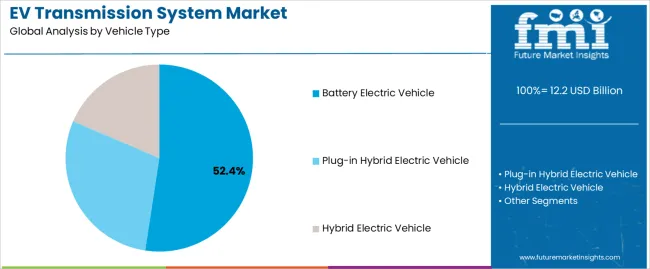
The Battery Electric Vehicle segment is projected to account for 52.4% of the EV transmission system market revenue in 2025, leading the market by volume and system deployment. This growth has been driven by regulatory pressures to reduce greenhouse gas emissions and a global shift toward electrified mobility.
Automakers have increasingly prioritized the rollout of BEV platforms over hybrids, with BEVs requiring purpose-built transmission systems tailored for electric propulsion. Additionally, government subsidies, tax credits, and urban emission restrictions have spurred consumer adoption of BEVs, resulting in higher demand for efficient and simplified transmission units.
Component manufacturers have responded by developing compact, single-speed gearboxes and CVTs that meet the specific torque and RPM requirements of electric drivetrains. With greater investments in BEV infrastructure, particularly fast-charging networks and battery technologies, the segment is expected to remain dominant in driving transmission system integration across various vehicle classes.
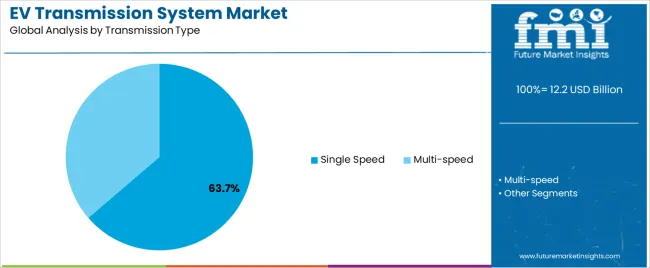
The Single Speed segment is projected to hold 63.7% of the EV transmission system market revenue in 2025, sustaining its position as the preferred configuration in electric vehicles. This dominance has been supported by the inherent torque characteristics of electric motors, which eliminate the need for complex multi-speed gear shifting.
Single-speed transmissions offer reduced mechanical loss, simplified control systems, and lower production costs, making them ideal for mass-market EVs. Automakers have widely adopted single-speed systems in their BEV lineups due to their ability to deliver smooth acceleration and consistent performance across varied driving conditions.
Furthermore, fewer moving parts have resulted in lower maintenance requirements and improved reliability, which are critical selling points in electric mobility. As energy efficiency and system durability remain top priorities for OEMs, the single-speed segment is expected to retain its lead, especially in urban commuter and passenger vehicle categories.
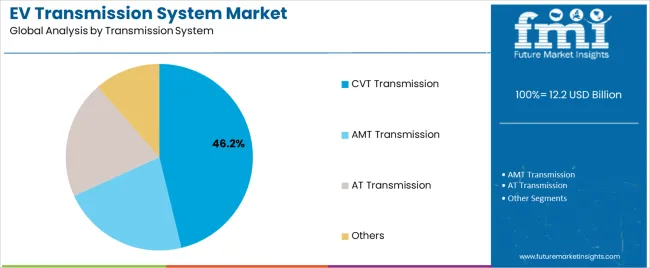
The CVT Transmission segment is projected to contribute 46.2% of the EV transmission system market revenue in 2025, emerging as a key system architecture within the market. Growth of this segment has been fueled by its ability to deliver smooth acceleration and maximize motor efficiency across a range of speeds.
Automotive technology forums and drivetrain specialists have identified CVTs as particularly beneficial in enhancing performance in EVs that operate under varying load conditions, including commercial and crossover vehicles. The ability of CVTs to maintain optimal motor operating points helps reduce energy consumption, contributing to longer vehicle range—one of the most critical parameters in EV adoption.
Additionally, recent innovations in belt-less and electronically controlled CVTs have improved durability and system response, aligning well with the needs of modern electric drivetrains. As manufacturers seek to balance performance, efficiency, and driving comfort, the CVT Transmission segment is expected to see growing deployment across multiple EV categories.
The following table showcases the projected CAGR for the global EV transmission system industry over semi-annual periods collectively spanning from 2025 to 2035. The sector is expected to rise at a CAGR of 17.8% in the first half (H1) of the decade, which spans from 2025 to 2035. The sector is subsequently projected to experience steady growth at a CAGR of 17.4% in the second half (H2) of the same decade.
| Particular | Value CAGR |
|---|---|
| H1 | 17.8% (2025 to 2035) |
| H2 | 17.4% (2025 to 2035) |
| H1 | 17.9% (2025 to 2035) |
| H2 | 17.6% (2025 to 2035) |
The upcoming period is estimated to experience relatively stagnant growth with a CAGR of 17.9% in the first half (H1) of 2025 to 2035. It will then see a minor decline in growth in the second half (H2) with a CAGR of 17.6%.
Impact of Charging Infrastructure Development on EV Transmission System Requirements
EV transmission system demand and side trends are greatly influenced by the development of novel charging infrastructure. Modifications are, therefore, necessary to maximize the charging efficiency, compatibility, and range. Transmission networks can effectively handle the power input from charging stations while ensuring compliance with numerous protocols owing to the advent of several charging standards as well as fast charging technologies.
Transmission systems are required to efficiently manage power input from charging stations while ensuring compatibility with different protocols amid the emergence of high-speed charging technologies and various charging standards. The development of charging infrastructure affects EV charging patterns, which subsequently impacts transmission system design to cater to a range of charging conditions. This includes fast public charging, overnight charge at home, and opportunistic charging. These require transmission systems that can control power input from multiple sources without compromising vehicle performance.
Safety and dependability are critical since transmission systems must endure fluctuations in power and voltage spikes arising from charging procedures. Robust transmission parts with embedded safety features guarantee dependable and secure operation while charging, reducing the possibility of transmission-related malfunctions.
Impact of Autonomous Driving on EV Transmission System Requirements
Autonomous driving technologies are transforming electric vehicle (EV) transmission system needs, demanding enhancements in design and performance. These systems emphasize efficiency optimization to fulfill the energy demands of autonomous driving whilst extending battery life.
Smooth integration with autonomous driving technologies is essential for coordinated vehicle control and effective performance. EV transmission systems are required to adapt to different driving circumstances encountered in autonomous mode, guaranteeing seamless gear shifts and power delivery for optimal vehicle performance and safety.
Emphasis on safety as well as reliability in autonomous driving conditions illustrates the requirement for powerful transmission components that are capable of enduring continuous operation and high torque demands. By satisfying these evolving criteria, EV transmission systems play an essential role in ensuring the flawless and efficient operation of autonomous electric vehicles. These help in contributing to the development of eco-friendly and autonomous mobility solutions.
Standardization Efforts and Regulations for EV Transmission Systems Globally
International standardization efforts and regulations of EV transmission systems have an enormous impact on the sector as these foster interoperability, safety, and innovation. These initiatives guarantee that the system will meet the common technical specifications and performance standards, thereby boosting compatibility and reliability across the sector.
By establishing security regulations along with performance requirements, rules foster customer trust in the safety and dependability of electric vehicles, strengthening acceptance and adoption. Standardization also stimulates innovation and technological developments by offering a framework for research, development, and testing, leading to increasingly efficient and modern transmission technologies.
Harmonized standards and regulations enhance sector access and global trade by decreasing technical hurdles and certification processes, enabling firms to reach new clients and sectors worldwide. Standardization efforts and regulations for EV transmission systems play an important role in shaping the business landscape, stimulating growth, and enabling the transition to sustainable transportation.
The global EV transmission system industry was valued at USD 6.7 million in 2020. The industry surged at a CAGR of 11.3% through the historical period of 2020 to 2025, attaining a value of USD 12.2 million by 2025. This growth was aligned with the rising sales of EVs worldwide.
Environmental concerns and government initiatives promoting the adoption of EVs prominently contributed to the growth of the industry. Single-speed transmissions were gaining popularity owing to simplicity and cost-effectiveness. Manufacturers were primarily focusing on performance and efficiency to attract consumer attention.
Automakers were progressively expanding EV model portfolios during this period to cater to diverse consumer preferences. The increase in the variety of EV models raised the demand for specialized transmission systems tailored to different vehicle types.
The sector has continued to witness robust growth in recent years and is projected to gain momentum, thereby securing the future of EV transmission systems. The industry is set to reach a value of USD 12.2 million in 2025 and is projected to rise at a CAGR of 17.8% from 2025 to 2035. The EV transmission market size is estimated to reach USD 40.7 million by 2035.
Factors driving the EV transmission system market are technological advancements in the automotive sector. Modernized technologies will require different transmission types, thereby increasing demand and production. Emerging economies and innovations can lead to potential cost reductions for EV transmissions.
The EV transmission system market future outlook suggests that Asia Pacific will emerge as the dominating sector owing to its extensive EV production base and government support. Europe is a robust industry for EVs with established players. However, the region is likely to face competition from Asia Pacific. North America and other regions are estimated to experience a significant rise in demand from the EV sector over the span of the next decade.
Corporations having an annual revenue of more than USD 25 million are incorporated in Tier 1 companies. Such companies stand out for having a broad international reach, extensive production capacity, and a diversified selection of products. These hold a share of 28% and cater to a wide range of requirements.
The leaders employ modern technologies and devotedly abide by regulatory standards. Renowned companies in Tier 1 consist of Dana Limited, ZF Friedrichshafen AG, AVL List GmbH, Continental AG, and Eaton.
Medium-sized companies that account for a value share of 45% fall under the Tier 2 category. These companies are based in specific locations and have a huge influence on the local sector. These players have strong industry knowledge and a prominent presence in the international sectors.
With a revenue ranging from USD 5 to 25 million, these companies guarantee compliance with regulations and the adoption of innovative technology in manufacturing processes. Esteemed industry players in the Tier 2 sector include Allison Transmission Inc., Aisin Seiki Co., Ltd., BorgWarner Inc., and GKN Plc.
With a 27% stake in the industry, small-scale enterprises make up most of the Tier 3 category. These companies register a revenue of up to USD 5 million and operate locally, catering to particular industries. These players have a limited geographical reach, which results in minimal competition. Compared to Tier 1 and Tier 2 companies, Tier 3 brands lack formalization and extensive structure.
The section below provides an analysis of the dominant countries in the industry. This data covers a broad range of topics, including country-specific consumer behavior, competitive dynamics, regulatory landscape, industry size, and growth prospects.
India and China are projected to emerge as the dominant countries in the sector during the assessment period. Spain, France, and Italy are following behind with favorable CAGRs of 13.4%, 12.5%, and 11.6%, respectively. By gaining a deeper understanding of regional sector statistics, companies can tailor specific product offerings, strategies, and marketing initiatives to efficiently meet the preferences and requirements of local consumers.
| Countries | CAGR 2025 to 2035 |
|---|---|
| India | 26.5% |
| China | 19.9% |
| Spain | 13.4% |
| France | 12.5% |
| Italy | 11.6% |
With a predicted CAGR of 26.5%, India is anticipated to dominate the global sector during the assessment period. The government of India is promoting the adoption of electric vehicles, thereby creating a considerable domestic sector. This translates to an increasing demand for EV components in the country.
Research reports on the EV transmission system market state that India holds the potential to become a cost-competitive producer owing to potentially low labor costs, making Indian-made EV transmissions attractive to global manufacturers. Various incentives provided by the government to set up manufacturing facilities for EV components are projected to foster domestic production and create a strong ecosystem for EV transmission systems.
The country has a huge population of skilled engineers and technicians who can be trained and upskilled to work in and develop the EV sector. The country holds a unique combination of factors that can help position it to become a dominant section in the EV transmission system market.
China is emerging as a leader in the EV transmission system sector, with an estimated CAGR of 19.9% through 2035. This growth is attributed to the country's well-established automobile sector. China is leading the adoption of electric vehicles, which has created a rising demand for EV components.
The government is actively supporting the EV sector by providing tax breaks, subsidies, and incentives to manufacturers and consumers. It is also prominently developing the infrastructure to suit the requirements of EVs. The country is progressively pushing localization of EV components as several companies are aiming to reduce dependence on foreign technology.
Spain is poised to become one of the leading sectors for EV transmission systems, with a projected CAGR of 13.4% from 2025 to 2035. The EV sector in the country is expected to experience robust growth over the next decade, thereby increasing the demand for EV components across Spain.
The country has a strong focus on renewable energy, thereby increasing the chances of EVs becoming an attractive choice owing to clean electricity generation. Spain has a high potential of becoming a significant player in the sector, but the country might face tough competition from the established players.
The section below provides investors with essential data and analysis of two leading categories of the target market, thereby helping them understand the EV transmission system market's future outlook and investment potential. By segmenting the industry into categories, businesses will achieve a comprehensive understanding of the latest market trends, drivers, restraints, and opportunities influencing each segment.
Based on vehicle type, battery electric vehicles are leading the segment with a value share of 44.4% in 2025. By transmission type, single-speed transmission is dominating the industry with a value share of 67.4% in 2025.
| Segment | Battery Electric Vehicle (Vehicle Type) |
|---|---|
| Value Share (2025) | 44.4% |
Battery electric vehicles (BEVs) are expected to hold a value share of 44.4% in 2025. These vehicles are experiencing faster growth compared to other electric vehicle types. This is owing to the presence of a well-established EV transmission industry specifically designed for battery electric vehicles worldwide.
Electric motors present in battery electric vehicles deliver high torque over a high-speed range. This enables BEVs to function efficiently with simple transmissions. With just the electric motors, the BEV transmission focuses on optimizing power delivery from the motor to the wheels.
| Segment | Single Speed (Transmission Type) |
|---|---|
| Value Share (2025) | 67.4% |
Single-speed transmissions are dominating the transmission type segment, with a share of 67.4% in 2025. These have a wide power band, resulting in strong acceleration and efficiency at various speeds. EVs can generate maximum torque even from a standstill, thereby eliminating the requirement for multiple power gears to attain starting power.
Companies are favoring single speed transmissions as these are simple to manufacture and install, contributing to low production costs for EVs. These transmissions maximize the EV operating range as these have few moving parts and reduce energy loss. The single-speed transmission also provides a smooth driving experience as these do not require constant gear changes.
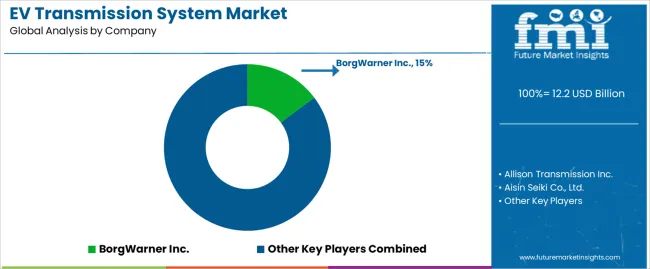
Growth in the EV transmission system market is primarily attributed to increasing sales of electric vehicles worldwide. The industry is highly fragmented, with not a single participant dominating the industry. This creates novel opportunities for new entrants.
The market is witnessing an ongoing race for superior EV transmission systems. This is leading to advancements in materials and designs as well as tough competition between single-speed and multi-speed transmissions. Manufacturers are working toward extending the EV range by creating transmissions with minimal power loss.
Emerging players and start-ups developing innovative EV transmission technologies will be required to look after the critical factor of balancing performance and affordability. The availability of lightweight transmissions is also set to contribute to the overall efficiency of EVs.
Industry consolidation is expected with advancements in technology. The rivalry is primarily set to revolve around cost, efficiency, and lightweight designs. However, innovation is anticipated to remain the chief driver.
Industry Updates
By vehicle type, the industry is divided into battery electric vehicles, plug-in hybrid electric vehicles, and hybrid electric vehicles.
Based on transmission type, the industry is segmented into single-speed and multi-speed.
By transmission system, the industry is divided into AMT transmission, CVT transmission, AT transmission, and others.
By region, the EV transmission system industry is spread across North America, Latin America, Western Europe, Eastern Europe, the Middle East and Africa, South Asia, and East Asia.
The global ev transmission system market is estimated to be valued at USD 12.2 billion in 2025.
The market size for the ev transmission system market is projected to reach USD 40.7 billion by 2035.
The ev transmission system market is expected to grow at a 12.8% CAGR between 2025 and 2035.
The key product types in ev transmission system market are battery electric vehicle, plug-in hybrid electric vehicle and hybrid electric vehicle.
In terms of transmission type, single speed segment to command 63.7% share in the ev transmission system market in 2025.






Full Research Suite comprises of:
Market outlook & trends analysis
Interviews & case studies
Strategic recommendations
Vendor profiles & capabilities analysis
5-year forecasts
8 regions and 60+ country-level data splits
Market segment data splits
12 months of continuous data updates
DELIVERED AS:
PDF EXCEL ONLINE
EV Charger Converter Module Market Forecast Outlook 2025 to 2035
EV Charging Panelboard Market Forecast Outlook 2025 to 2035
Evacuated Miniature Crystal Oscillator (EMXO) Market Forecast and Outlook 2025 to 2035
EV Charging Tester Market Size and Share Forecast Outlook 2025 to 2035
Evaporative Air Cooler Market Size and Share Forecast Outlook 2025 to 2035
EV Charging Cable Market Size and Share Forecast Outlook 2025 to 2035
EVOH Encapsulation Film Market Size and Share Forecast Outlook 2025 to 2035
eVTOL Charging Facilities Market Size and Share Forecast Outlook 2025 to 2035
Event Tourism Market Size and Share Forecast Outlook 2025 to 2035
Evidence Collection Tubes Market Size and Share Forecast Outlook 2025 to 2035
EV Battery Recycling and Black Mass Processing Market Analysis - Size, Share, and Forecast Outlook 2025 to 2035
EVA Coated Film Market Size and Share Forecast Outlook 2025 to 2035
EV Charging Management Software Platform Market Size and Share Forecast Outlook 2025 to 2035
EV EMC Battery Filter Market Size and Share Forecast Outlook 2025 to 2035
EV Traction Inverter Market Size and Share Forecast Outlook 2025 to 2035
EV Plant Construction Market Size and Share Forecast Outlook 2025 to 2035
EV Charging Station Market Analysis - Size, Share, and Forecast Outlook 2025 to 2035
Event Logistics Market Size and Share Forecast Outlook 2025 to 2035
Evaporated Filled Milk Market Size, Growth, and Forecast for 2025 to 2035
EV Lighting Market Growth - Trends & Forecast 2025 to 2035

Thank you!
You will receive an email from our Business Development Manager. Please be sure to check your SPAM/JUNK folder too.
Chat With
MaRIA